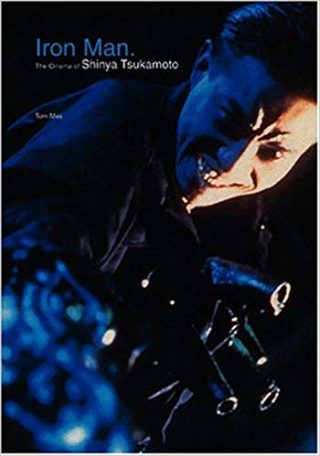Japan’s Shinya Tsukamoto is one of the world’s most vital living filmmakers, and this exhaustive study of his life and films is an essential reference, ideal both for Tsukamoto fanatics like myself and those new to the filmmaker’s work. Shinya Tsukamoto, of course, is the genius creator of classic freak-outs like TETSUO and its sequel, as well as HIRUKO THE GOBLIN, TOKYO FIST, GEMINI and A SNAKE OF JUNE. All are incredibly intense, disturbing films characterized by kinetic editing, astounding low budget special effects and complex narratives revolving around the human body and its attendant horrors and metamorphoses. Said films, which the fiercely independent Tsukamoto wrote, shot and edited himself, tend to be categorized as horror, cult or cyberpunk, but are in fact among the most distinctive and influential cinema of any category.
Tom Mes has a penned a lively account of Tsukamoto’s life and films that contains quite a few revelations, such as the surprising fact that Tsukamoto had already completed nine films, three of them feature length, by the time he made his 1989 “debut” TETSUO. Mes also notes that Tsukamoto acts steadily in other directors’ projects (although “only in the films of directors I like”) and does extensive commercial voice-over work in his native Japan (voicing an average of 25 ads a year). Other revelatory bits include a reminiscence of a 1992 visit Tsukamoto and his pals Gaspar Noe (of IRREVERSIBLE) and Marc Caro (CITY OF LOST CHILDREN) paid to the Paris home of EL TOPO creator Alejandro Jodorowski, and the fact that Quentin Tarantino was at one point slated to produce TETSUO 3.
Perhaps the book’s biggest surprise, however, is the simple fact that Tsukamoto, whose films are packed with rage, insanity and bodily mutilation of every conceivable variety, comes off as a kind-hearted, easy-going person throughout. Indeed, fellow Japanese “cult” filmmaker Takashi Miike (whose films include ICHI THE KILLER, which Tsukamoto performed in) reveals in his introduction that his “honest impression” upon first meeting Tsukamoto was “Huh? He’s just a regular nice guy.”
Tom Mes includes in-depth analyses of his subject’s eight major features and extensive interviews with collaborators like Kei Fujiwara, who was heavily involved in the production of TETSUO (and went on to write and direct 1996’s ORGAN), and the filmmaker’s brother Koji, who’s acted in a number of Shinya’s films and has a decidedly complicated relationship with his sibling. The book overall is an improvement on the author’s previous tome, 2003’s AGITATOR—THE CINEMA OF TAKASHI MIIKE, which despite its considerable virtues was somewhat bloated and fragmentary. IRON MAN, in contrast, is lean and streamlined, and, at a sprightly 237 heavily illustrated pages, never overstays its welcome. I can’t imagine a better study of this essential filmmaker, and recommend it unreservedly

